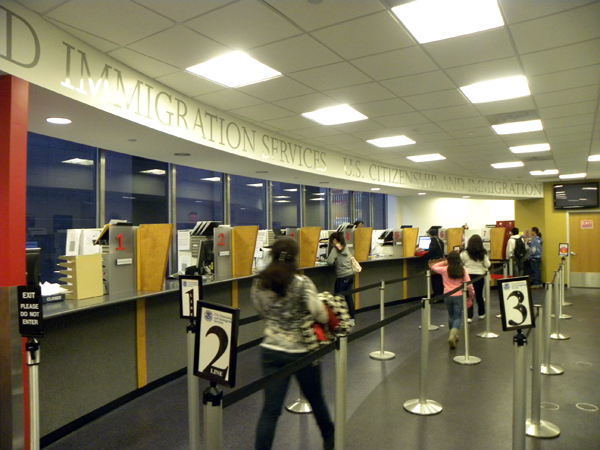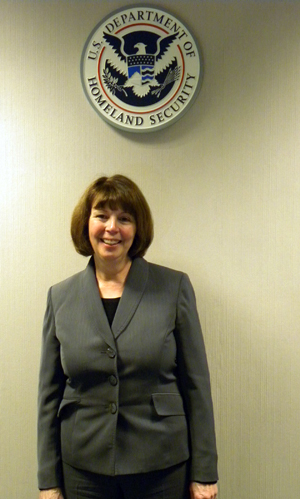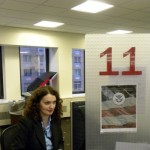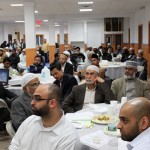
The customer service area at 26 Federal Plaza, New York USCIS headquarters. (Photo: Ewa Kern-Jedrychowska)
Many foreign-born New Yorkers get butterflies in their stomach when they remember their experiences at immigration offices. Some get flashbacks of the long lines, others wince at the uncomfortable interviews and difficulties accessing basic information about their cases.
But the New York representatives of U.S. Citizenship and Immigration Services (USCIS) —a branch of the Homeland Security Department, created in 2003 to oversee lawful immigration to the U.S. after the former Immigration and Naturalization Service was disbanded, claim these sentiments are outdated and do not reflect the current situation at the federal agency.
Nowadays customers can make an appointment online using a system called Infopass. Those who come to the USCIS New York headquarters at 26 Federal Plaza are ushered into neat customer service sections with monitors displaying their numbers and flat screen TVs displaying NY1. A showcase with old pictures of immigrants at Ellis Island hangs in the corridor and the wallpaper features images of the American flag and Lady Liberty.
Some who regularly deal with the immigration office have noticed an improvement. “They sped up the processing time a lot,” says Stanislaw Szumigraj, 38, a truck driver from Queens, who came to the U.S. from Poland in 1995 and got his citizenship last year. “And now everything is available online.” That was not the case when he applied for a green card in 1998. “Back then the only way to find out anything about my case was through the lawyer. Moreover, the backlog was (so) big that there was no point in checking anyway,” he said.
But the office makeover hasn’t entirely quelled the anxiety non-citizen immigrants feel towards the federal authorities. Regular raids on immigrant homes and workplaces, and the growing numbers of deportations – even though they are conducted by ICE, a different branch of DHS – have made many people increasingly fearful.
Allaying those fears is part of the reason the New York USCIS recently launched a program to engage local ethnic communities and get them comfortable with the office while simultaneously helping them prepare for the citizenship test. “They are afraid of the test, they are afraid of what we’ll ask them, they are afraid their English isn’t good, that their understanding of history isn’t good enough,” said the USCIS New York District Director Andrea Quarantillo during a recent interview.
The program relies on community groups that teach English and civics for the citizenship test. During presentations, usually held in the evening, USCIS representatives explain the naturalization process and hold a mock interview. The agency is also helping community groups become accredited by the Board of Immigration Appeals, an appellate body that reviews the decisions in various immigrant cases, so that they can represent their clients before the board.
“We rely on those groups and we know they have the expertise, the experience, the knowledge and that they don’t overcharge. And we want to encourage immigrants to use those groups instead of going to the storefront down the street,” stressed Quarantillo, adding that part of her agency’s mission is to warn immigrants about various swindlers who prey on their vulnerability.
The groups already have the community’s trust, so it’s easier for USCIS to get its message across. Currently the New York USCIS has a list of approximately a hundred groups of this kind and wants to expand it so that all the major ethnic communities in the city have access to the program.
“The problem is you have to get groups on that list that have the same language, culture, religious background as the person that is looking for help. So if someone of Polish origin is looking for help, they are not going to HIAS, they’re not going to Hispanic organization, they would probably go to a Catholic organization or group that speaks Polish. But if they don’t see that on that list, they’re not going.” Quarantillo said that’s the case with many Muslims and Middle Easterners. “None of those groups are on those lists,” she said.
Quarantillo’s advice to immigrants? “If you have a problem with immigration or with the criminal justice system, you need to solve it before you file your paperwork so that you don’t end up in immigration court and things like that. Because when you file those papers, then you force us to put on our Homeland Security hat instead of our customer service hat,” she said.
The director said these days the agency is able to process cases faster because FBI background checks no longer cause long backlogs. “We fixed that about 3 years ago,” Quarantillo said. “We get all our results now within 90 days at the very most; most of them within 30. But if the answer is ‘yes’ then it can hold up the case.” Quarantillo says it happens with a very small percentage of the cases, “no more than maybe 500 a year.” She estimates that the three New York district offices handle about 250,000 applications a year, which includes about 85,000 to 100,000 citizenship applications and 35,000 to 50,000 green card cases.
Amid strong anti-immigrant sentiment around the country and lack of political will for national immigration reform, Quarantillo hopes her agency’s outreach efforts will let immigrants breathe a little easier. “We know that people are afraid because the economy is bad and enforcement is strong. But we think this kind of help can lower the anxiety level a little bit,” she said.
Community groups who are interested in working with USCIS should send an e-mail to: nyc.community.relations@dhs.gov.
This article also appeared in Polish in Nowy Dziennik/Polish Daily News.
Fi2W is supported by the New York Community Trust and the John S. and James L. Knight Foundation with additional support from the Mertz Gilmore Foundation.





